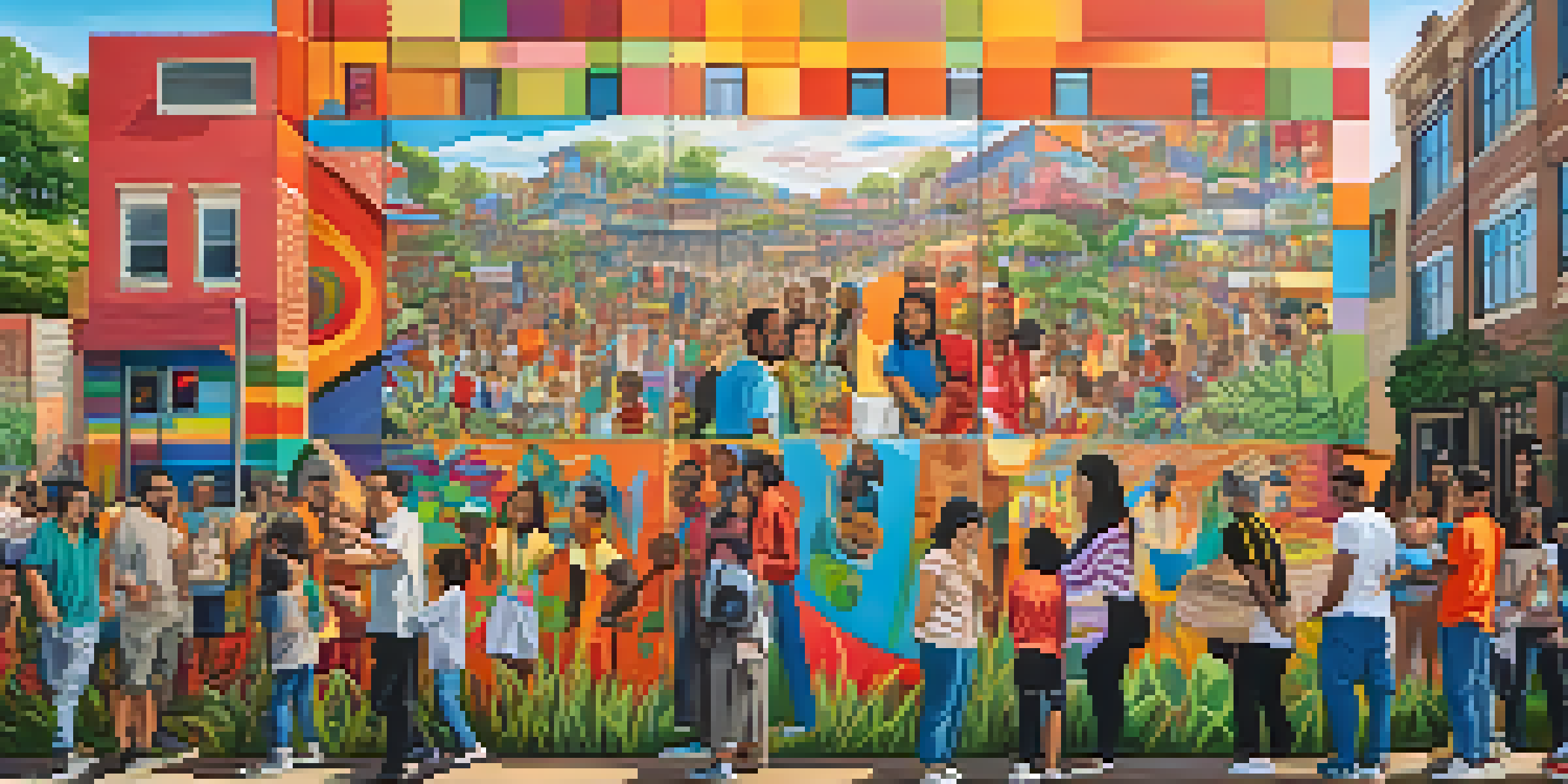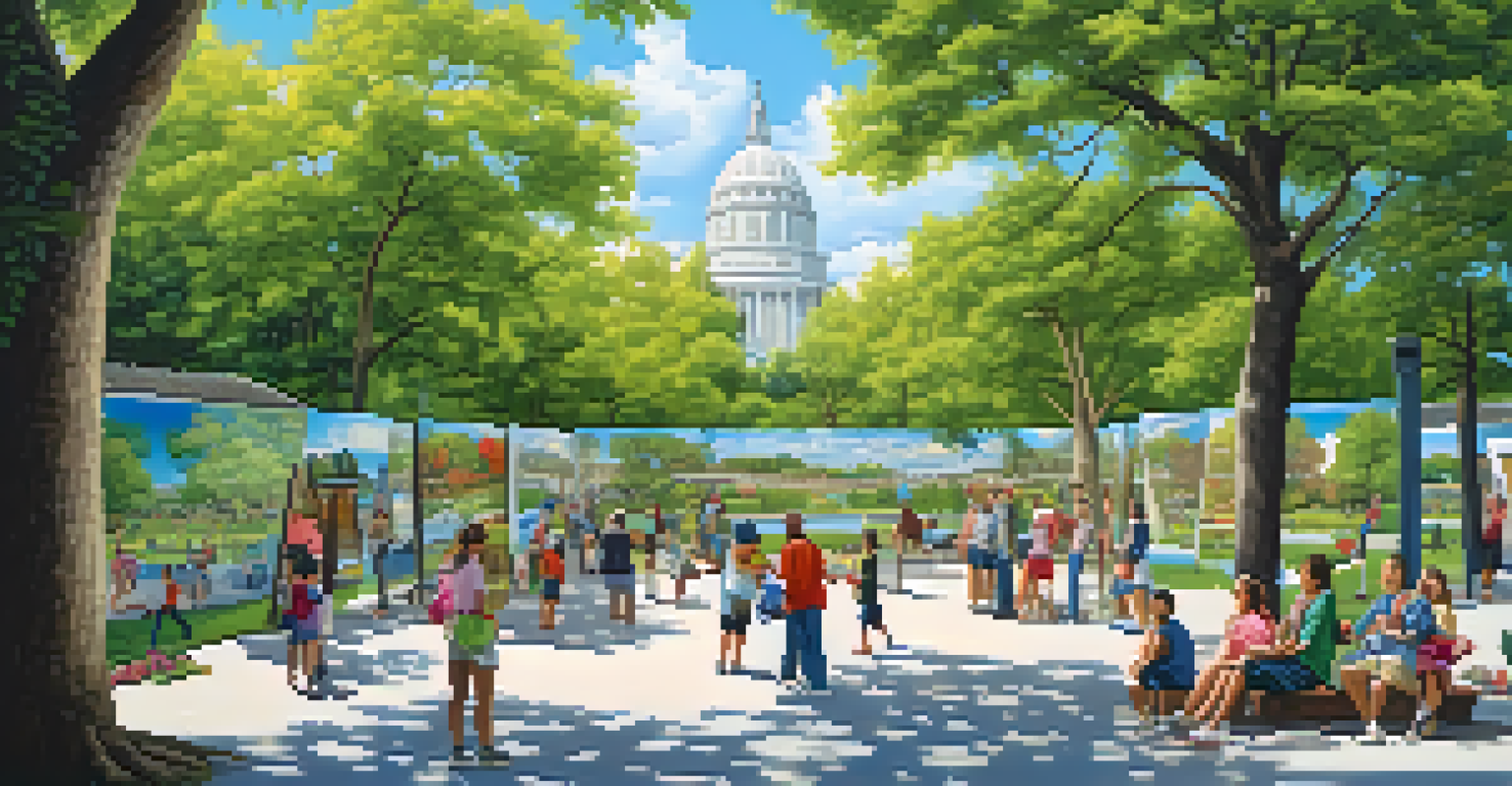How Collaborative Art Increases Social Cohesion in Communities

Understanding Collaborative Art and Its Impact
Collaborative art is a creative process where individuals come together to create something meaningful. This could range from murals to community sculptures, where each participant contributes their unique touch. By uniting people from diverse backgrounds, collaborative art nurtures a sense of belonging and shared purpose.
Art enables us to find ourselves and lose ourselves at the same time.
For instance, think of a community mural where each artist paints a section that represents their personal story. As they work side by side, they not only express themselves but also learn about each other's experiences. This exchange fosters empathy and understanding, key ingredients for social cohesion.
Ultimately, collaborative art transforms solitary acts of creation into collective experiences, breaking down barriers and encouraging deeper connections among community members.
Building Bridges Through Shared Experiences
One of the most powerful aspects of collaborative art is its ability to create shared experiences. When people engage in a joint artistic endeavor, they often step out of their comfort zones, building bridges with others. This shared vulnerability can lead to stronger interpersonal connections and a sense of unity within the community.

Consider a community workshop where participants come together to create a large quilt. As they stitch together their individual pieces, they’re not just crafting a fabric artwork; they’re weaving stories, memories, and cultures into a single tapestry. Each piece becomes a symbol of collaboration and mutual respect.
Art Fosters Community Connections
Collaborative art brings individuals together, creating shared experiences that enhance empathy and social cohesion.
These shared experiences can spark conversations that might not happen in everyday life, helping to foster a culture of openness and inclusivity. This cultural exchange is essential for nurturing social cohesion.
Fostering Inclusivity in Diverse Communities
Collaborative art projects often serve as a platform for inclusivity, inviting individuals from various backgrounds to participate. This inclusivity is vital in diverse communities, where different perspectives can enrich the artistic process. When everyone has a voice, it cultivates an environment where all feel valued and heard.
The greatness of a community is most accurately measured by the compassionate actions of its members.
For example, a community art project focused on local history could invite contributions from residents of different ages, ethnicities, and backgrounds. Each participant brings their own narrative, which can highlight the community's rich tapestry. This collective storytelling reinforces a shared identity.
As people collaborate and learn from each other, it reduces stereotypes and fosters mutual respect, ultimately strengthening the social fabric of the community.
Encouraging Civic Engagement Through Art
Collaborative art can also encourage civic engagement, prompting community members to take an active role in local issues. Engaging in projects that reflect community concerns helps individuals feel more invested in their surroundings. When people see their voices represented in art, it can inspire them to advocate for positive change.
Take, for instance, a community-led art installation addressing environmental issues. As residents collaborate on this project, they not only raise awareness but also create a sense of ownership over the issue. This involvement can lead to further discussions and actions aimed at improving their neighborhood.
Inclusivity Enriches Artistic Expression
By inviting diverse voices into the creative process, collaborative art projects cultivate an environment where all participants feel valued.
By participating in these projects, individuals become more connected to their community, leading to increased civic pride and responsibility.
The Role of Public Spaces in Collaborative Art
Public spaces play a crucial role in the success of collaborative art projects. These venues provide a neutral ground where community members can gather and express themselves freely. When art is created in public spaces, it becomes accessible to everyone, encouraging participation from all quarters of the community.
Imagine a local park transformed by a series of community murals. Not only do these artworks beautify the area, but they also invite passersby to engage with the artists and the stories behind the pieces. Such interactions can spark interest and inspire others to contribute their own artistic voices.
Therefore, fostering creative expressions in public spaces can nurture a sense of ownership and pride among community members, further enhancing social cohesion.
Promoting Healing and Resilience After Adversity
Collaborative art can serve as a powerful tool for healing, particularly in communities facing adversity. After crises, such as natural disasters or social unrest, art projects can help individuals process their emotions and experiences together. This collective healing fosters resilience and strengthens community bonds.
For example, a community may come together to create a memorial mural honoring those lost in a tragedy. As artists and residents join forces in this healing process, they not only celebrate lives but also support one another through shared grief. This camaraderie can be incredibly uplifting in difficult times.
Art Encourages Civic Engagement
Engaging in community art projects inspires individuals to take an active role in addressing local issues and fosters a sense of ownership.
Such projects not only help communities recover but also empower them to emerge stronger and more united than before.
Sustaining Community Engagement Beyond Art Projects
The impact of collaborative art extends far beyond the initial project. Once community members have engaged in a creative endeavor, they often feel more motivated to maintain connections and pursue further collaborative efforts. This sustained engagement can lead to long-term improvements in social cohesion.
For instance, a community that successfully organizes a mural project may find that participants want to establish ongoing art workshops or cultural events. This continuity fosters a vibrant community spirit, where individuals are actively involved in shaping their environment.

Ultimately, the relationships built during these projects can lead to a more resilient and interconnected community, capable of tackling future challenges together.